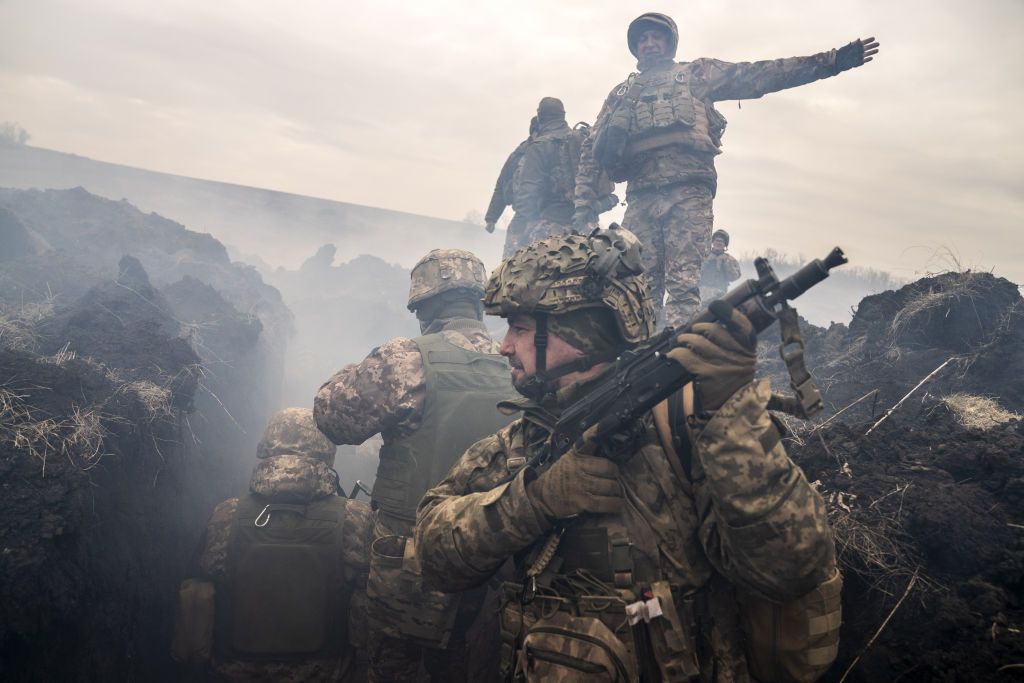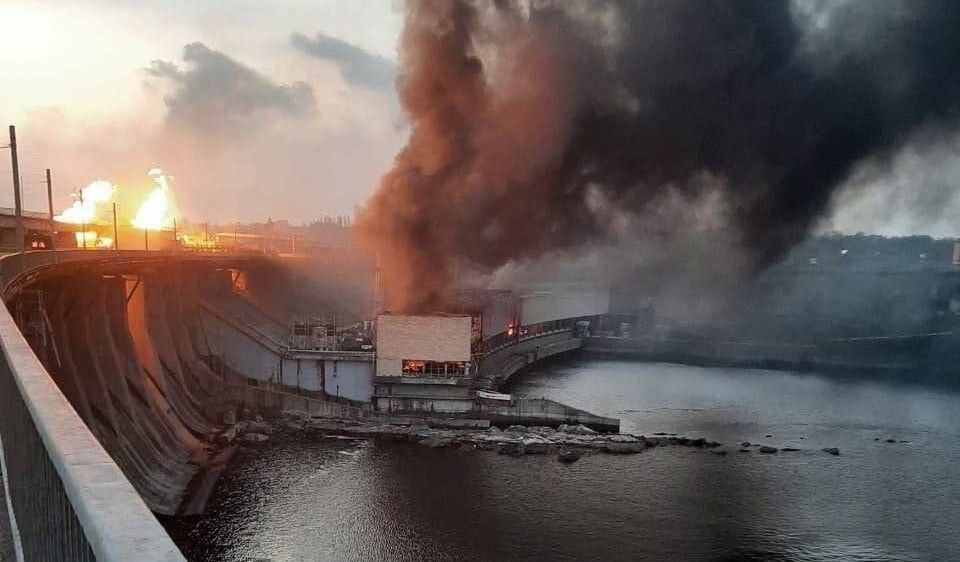Ukraine war latest: Russian assault on Kharkiv can't be ruled out, chief commander says

Key developments on March 29:
- Russian assault on Kharkiv can't be ruled out, chief commander says
- Syrskyi: 500,000 mobilization figure 'significantly reduced'
- Zelensky: Russia targets Kaniv, Dnister hydroelectric power plants overnight
- Romania says it found possible drone fragments on its territory following Russian attack on Ukraine
- Defense committee considers all parliamentary amendments to mobilization bill.
Russia's attempt to take the city of Kharkiv can't be ruled out, Commander-in-Chief of Ukraine's Armed Forces Oleksandr Syrskyi said on March 29.
In an interview with Ukrinform, Syrskyi said Ukraine's Armed Forces were "taking all measures to adequately respond to such a possibility."
Kharkiv, Ukraine's second-largest city, located just over 30 kilometers south of the Russian border, has in recent weeks seen an escalation in strikes from Russian missiles, drones, and air bombs.
A recent report by Latvia-based Russian media outlet Meduza claimed "political elites" have not ruled out that President Vladimir Putin will order a ground offensive against the city.
"Today, we are carrying out a large scale of works on the fortification of territories and positions, we are installing a complex system of barriers," Syrskyi said.
Referencing the liberation of parts of Kharkiv Oblast in 2022 after seven months of Russian occupation, Syrskyi said Ukraine's Armed Forces already had experience of military operations in the region which caused the "large-scale collapse of the Russian front."
"If the Russians go there again, Kharkiv will become a fatal city for them," he added.
In the same interview, Syrskyi said that despite being outmanned and outgunned, Ukraine's use of drones and high-precision artillery mean Russian troops "can never feel safe" even far from the front lines.
He also acknowledged the "very difficult" situation on the front, saying Moscow’s forces continue to use mass assaults and has recently significantly increased the use of air strikes and guided bombs "that destroy our positions."
Syrski also said Russian forces currently enjoy an ammunition advantage of around 6:1, adding that Ukraine is helped by high-precision ammunition.
"Our gunners use high-precision ammunition to destroy enemy concentrations even tens of kilometers from the front line," he added.
Syrskyi: 500,000 mobilization figure 'significantly reduced'
The number of people who need to be mobilized has been "significantly reduced" from the initially proposed 500,000, Ukraine's Commander-in-Chief Oleksandr Syrskyi said on March 29.
In an interview with Ukrinform, Syrskyi said the figure had been reviewed and "we expect we will have enough people capable of defending," though he did not specify the new estimates.
In December, President Volodymyr Zelensky said Ukraine's military leadership – then headed by Valerii Zaluzhnyi – had proposed to mobilize 450,000-500,000 additional conscripts in order to ensure sufficient rotation of troops from the front lines.
"They are exhausted, physically and psychologically, especially in combat conditions," Syrskyi said, adding that "the 110th combat brigade was involved in the Avdiivka direction from the beginning of the full-scale invasion."
"They need to recover and rest, and this is an objective necessity. And there are many such units," Syrskyi added.
Syrskyi stressed that those who are mobilized are not "immediately sent to the front."
"With very special exceptions, for example, when a person already has combat experience, the vast majority of these individuals arrive at training military units and centers," he said.
A draft law on mobilization is currently being amended by lawmakers, and proposes to lower the enlistment age and introduce basic military training for adults.
In early February, Ukraine's parliament passed the updated bill on mobilization in the first reading, a few weeks after its initial, contentious version was withdrawn.
The draft law proposes the mobilization from the age of 25 to 60, according to the ministry. Citizens from the age of 18 can choose the time of basic military service.
In addition, regardless of basic military training or service, they will receive a deferral until they reach the conscription age.
According to the bill, basic military training will be introduced in higher education institutions starting in 2025, with certain categories of citizens exempted from it.
Basic military service will be introduced instead of conscript service and will last five months in peacetime and three months in wartime.
More than 4,000 amendments to the bill have been submitted since its passing in the first reading.
Zelensky: Russia targets Kaniv, Dnister hydroelectric power plants overnight
Russian troops attacked the Kaniv Hydroelectric Power Plant in Cherkasy Oblast and the Dnister Hydroelectric Power Plant in Chernivtsi Oblast during an attack on March 29, President Volodymyr Zelensky said.
The overnight large-scale Russian strike targeted energy and civilian infrastructure in 10 of Ukraine's regions, according to Interior Minister Ihor Klymenko. At least six people, including a child, were injured in the attack, he said.
DTEK, Ukraine's largest private energy company, said that three of its power plants were struck and seriously damaged, without disclosing where the impacted power plants were located. Ukraine shot down 84 out of the 99 Shahed-type drones and missiles overnight, Air Force Commander Mykola Oleshchuk reported.
The two hydroelectric power plants were "deliberate targets" of Russian forces, Zelensky wrote on Telegram. He said that Moscow "wants to repeat" the Kherson Oblast disaster, referring to the Kakhovka dam destruction in June 2023.
"But now not only Ukraine, but also Moldova, is under threat. The water will not stop before the border pillars, just as the Russian war will not stop if we do not stop it in Ukraine together in time," Zelensky said.
The Dnister Hydroelectric Power Plant is located a few kilometers from the Ukrainian-Moldovan border. Monitoring Telegram channels claimed that a Russian missile allegedly entered Moldovan airspace during the attack. Kyiv could not confirm this information, Illia Yevlash, the Air Force's spokesperson, said on national television.
Earlier on March 22, Russian missiles hit the Dnipro Hydroelectric Power Plant, Ukraine's largest hydroelectric station, during the biggest attack on the country's energy infrastructure since the beginning of the full-scale invasion.
In Romania, which borders with three regions in the west of Ukraine and Odesa Oblast in the south, the alleged fragments of a drone near the Ukrainian border were found, the country's Defense Ministry said on March 29.
The Hydroelectric Power Station-2 (HPS-2), one of the two stations of Zaporizhzhia's Dnipro Hydroelectric Power Plant, is in critical condition following the attack. The dam itself suffered damage as well, but officials said that there was no risk of a breach.
Romania says it found possible drone fragments on its territory following Russian attack on Ukraine
Romania's Defense Ministry said on March 29 that it found what appeared to be fragments of a drone on its territory near the Ukrainian border.
The statement came after repeated waves of Russian attacks throughout Ukraine.
It was not the first time that wreckage of drones, likely from Russia, has been found on Romanian territory. Russia has repeatedly targeted Ukrainian port infrastructure on the Danube River that separates Ukraine and Romania.
The defense ministry said that the fragments were found on the evening of March 28 on Great Braila Island, located roughly 45 kilometers (28 miles) from the Ukrainian port city Reni.
Romanian President Klaus Iohannis said in September 2023 that while Russian drones are not intentionally targeting Romania, the situation is still "unacceptable."
Romania has taken measures to protect its citizens who live close to the Ukrainian border, including the construction of air raid shelters and the deployment of drone defense systems.
Turkish F-16 fighter jets at an airbase in Romania were scrambled in February 2024 following a Russian drone strike on Odesa.
Defense committee considers all parliamentary amendments to mobilization bill
The parliament's National Security and Defense Committee reviewed all the 4,269 parliamentary amendments to a mobilization bill, lawmaker Yaroslav Zhelezniak said on March 29.
The lawmaker estimated that the bill would be considered in the plenary hall in two weeks, adding that he does not expect any delays.
Ukraine's government hopes to update the legal framework around conscription in order to ramp up mobilization in 2024. The parliament is now considering a new draft of the mobilization law after its initial, contentious version was withdrawn.
The parliament supported the updated bill in the first reading on Feb. 7.
Zhelezniak stressed that the Defense Committee's conclusions do not mean that the bill is "100% ready" for a vote in the second reading, as additional committee amendments must be considered, and a final comparative table must be drafted.
The Defense Ministry presented key points of the revised mobilization bill on March 27. The proposal includes mobilization from the age of 25 to 60 and an introduction of basic military training instead of conscript service.
President Volodymyr Zelensky initially said that the bill calls for a mobilization of 450,000-500,000 additional conscripts, but Commander-in-Chief Oleksandr Syrskyi said earlier on March 29 that this number has been "significantly reduced."

















